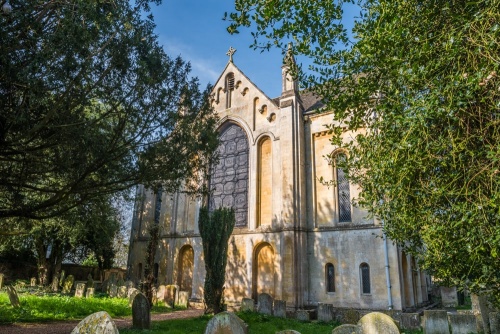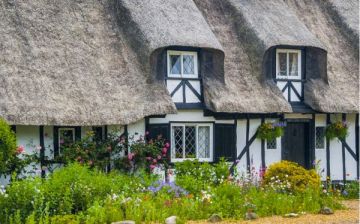
A religious settlement was established at Thorney about AD 662 by Saxulf, who also founded Peterborough, then called Medehamstede. Saxulf's foundation was not a monastery in the traditional sense, but a community of anchorites living an isolated life on what was then no more than an island in the fens.
History
This patch of high ground in the marshes became known as the 'Island of the Hermits'.
The religious settlements of the Fenland region were devastated by Danish attacks in AD 870, but the monks of Thornton escaped the worst of the Danish depredations and were thus able to help bury their less fortunate fellows at Peterborough.
Another version of the tale says that Thorney was destroyed in the Danish attacks and the island was abandoned and became overgrown with thorn bushes, giving us the name Thorney, or 'island of thorns'.

Religious Reform
The abbey was refounded on Benedictine lines in AD 972 by St Aethelwold, Bishop of Winchester from 963-984. Aethelwold had a reputation as a religious reformer, pushing rulers to support monasteries at the expense of secular clergy.
With King Edgar's support, Aethelwold acquired estates across Huntingdonshire to support the new abbey and gave the monks relics of former anchorites and local saints.
He bought the remains of Benedict Bishop, who had founded the monasteries at Jarrow and Wearmouth and acted as tutor to the Venerable Bede. Aethelwold also brought the body of St Botolph from Boston, along with Botolph's brother Adolf, and the relics of Hereferth, Bishop of Winchester, who was killed by the Danes in AD 833. Thereafter, Thorney was known as the Church of St Mary and St Botolph.

Thorney Abbey benefitted from royal patronage under King Cnut, and even into the Norman period the abbots of Thorney were appointed by the king.
The Norman Abbey
Under the rule of Abbot Gunther (1085-1112) the old Saxon church was pulled down and a larger building in Norman style was begun. That church was not consecrated until 1128.
The abbey was expanded in the early 14th century, but it suffered badly from the Black Death of 1349 when 13 monks and 100 lay members died. In the aftermath of the plague the abbey went into a decline.

The Abbey Dissolved
Thorney Abbey was disbanded at the Dissolution of the Monasteries under Henry VIII. The remaining 20 monks were pensioned off, and the abbot was allowed to retire. The abbey was stripped of building materials, much of which went to assist the erection of the chapel at Corpus Christi College at Cambridge University. In 1550 the abbey was sold to John Russell, the Earl of Bedford.
The abbey church was partially spared as the five westernmost bays of the nave were adapted to serve as the parish church. The aisles were pulled down and the arcade arches filled in.

The Abbey Church Today
The present east end of the church is the work of Edward Blore and was added in 1840.
The best remaining part of the original abbey church is the superbly carved west front, featuring figures of saints in a horizontal row of niches, plus carved heads of beasts above the arched doorway. Interior highlights include stained glass thought to have been brought here from the London trading base of the Hanseatic League.
Getting There
Thorney Abbey is very easy to find. It stands on Abbey Place (the B1040) in the centre of Thorney, just south of the crossroads in the middle of the village. It is generally easy to find parking along Abbey Place.
About Thorney Abbey
Address: Thorney,
East Anglia,
Cambridgeshire,
England, PE6 0QB
Attraction Type: Historic Church
Location: In the centre of Thorney, on the B1040. Plentiful on street parking.
Website: Thorney Abbey
Location
map
OS: TF282042
Photo Credit: David Ross and Britain Express
POPULAR POSTS
HERITAGE
 We've 'tagged' this attraction information to help you find related historic attractions and learn more about major time periods mentioned.
We've 'tagged' this attraction information to help you find related historic attractions and learn more about major time periods mentioned.
Historic Time Periods:
Find other attractions tagged with:
10th century (Time Period) - 11th century (Time Period) - 7th century (Time Period) - Henry VIII (Person) - Medieval (Time Period) -
NEARBY HISTORIC ATTRACTIONS
Heritage Rated from 1- 5 (low to exceptional) on historic interest
Croyland Abbey - 4.6 miles (Abbey) ![]()
Flag Fen - 4.7 miles (Prehistoric Site) ![]()
Peterborough Cathedral - 6.5 miles (Cathedral) ![]()
Peterborough Museum and Art Gallery - 6.7 miles (Museum) ![]()
Parson Drove, St John's Church - 7.2 miles (Historic Church) ![]()
Guyhirn Chapel - 7.4 miles (Historic Church) ![]()
Longthorpe Tower - 8.3 miles (Castle) ![]()
March Museum - 9.6 miles (Museum) ![]()
Nearest Holiday Cottages to Thorney Abbey:
Peterborough, Cambridgeshire
Sleeps: 15
Stay from: £2056.00 - 12450.00
Upwell, Cambridgeshire
Sleeps: 8
Stay from: £679.00 - 2952.00
More self catering near Thorney Abbey












